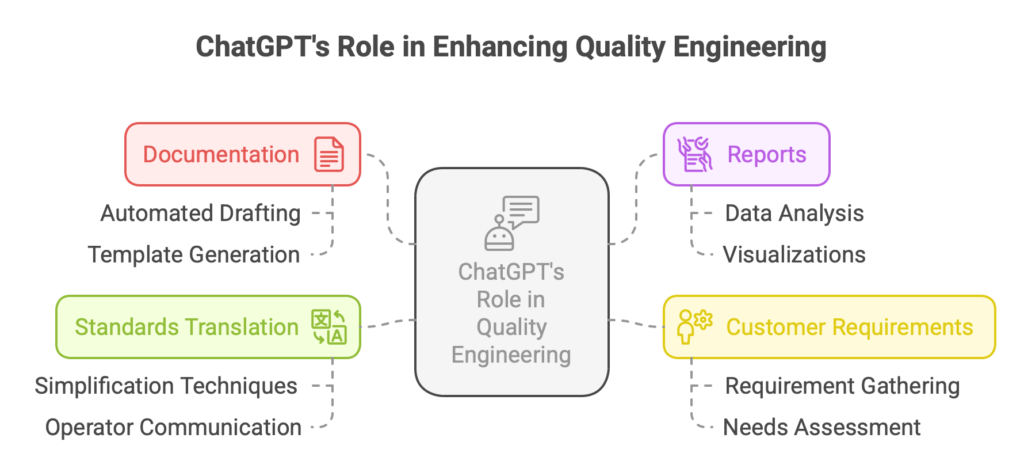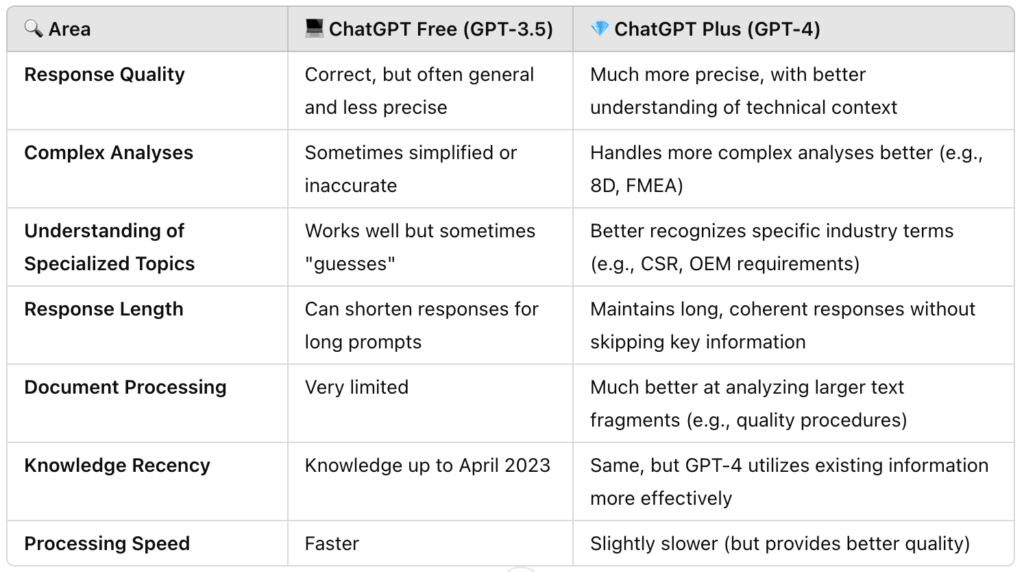Artificial intelligence is revolutionizing many industries, including quality in the automotive sector. ChatGPT for Quality Engineers is a valuable tool that supports daily tasks—from creating documentation to conducting problem analysis.
What are its capabilities, what are its limitations, and how can it be used effectively? Find out in this article.
Why is ChatGPT Useful for Quality Engineers?
The work of a quality engineer is not just about checking components or analyzing complaints. It also involves numerous tasks related to:
- Creating documentation,
- Preparing reports,
- Analyzing customer requirements,
- Translating complex standards into a language understandable for operators.
These repetitive but time-consuming areas are where ChatGPT can be very helpful.

Applications of ChatGPT in Quality Engineering
1. Creating Quality Documentation
ChatGPT can effectively generate drafts of essential quality documents, such as:
- 8D reports
- Meeting summaries with customers and suppliers
- Audit checklists (Process, LPA)
- Descriptions of corrective and preventive actions
Pro Tip!
When creating prompts, it’s best to use a two-step approach:
Step 1 – Create a basic prompt, such as:
“Create a draft 8D report for the following problem: damaged surface of a part after anodizing. Use the standard 8D format.”
Step 2 – Copy this text into a Prompt AI Generator like Feedough AI Prompt Generator to refine and enhance it.
It should look like the example below. Then, click “Generate.”

This method generates a more detailed and structured prompt, improving ChatGPT’s output.

2. Supporting Complaint Analysis
Another area where ChatGPT can help includes:
- Creating supplier escalation questions
- Preparing 5Why or Ishikawa analyses
- Checking whether the root cause description in an 8D report is logical and consistent
Example prompt:
“Perform a 5Why analysis for the issue: incorrectly labeled packaging of finished products.”
Using a Prompt AI Generator, we obtain a refined version:
You are a skilled problem-solving expert with extensive experience in conducting 5 Whys analyses to uncover the root causes of issues in various industries. You excel at guiding teams through the process to ensure clarity and thoroughness in identifying underlying problems.
Your task is to perform a 5 Why analysis for the issue of incorrectly labeled packaging of finished products.
Begin by outlining the primary problem statement: “Incorrectly labeled packaging of finished products.”
As you progress through the 5 Whys analysis, consider factors such as human error, processes, training, and quality control measures. Be sure to articulate each “Why” clearly, ensuring that each response leads logically to the next question.
To assist in your analysis, keep in mind the following points:
Focus on actionable insights rather than just identifying issues.
Provide potential solutions or corrective actions at each stage of the analysis.
Here’s the structure you should follow for your 5 Whys analysis:
Why is the packaging of finished products labeled incorrectly?
Why does this occur?
Why is this happening consistently?
Why aren’t current processes preventing this?
Why is there a lack of oversight or accountability in the labeling process?
The difference is significant – this method saves time while enhancing precision. Obviously feel free to modify the prompts as necessary to adapt to the specific context of the issue at hand.
3. Technical and Quality Translations
Many quality engineers work in an international environment, where English is the standard. ChatGPT excels as a:
- Translator for quality documentation
- Proofreader for emails to customers and suppliers
- Generator of professional responses to audit questions
Example prompt:
“Translate the following 8D report into English while maintaining a formal, technical style.”
Before entering the text into ChatGPT, make sure to refine the prompt for a more precise and professional translation.
4. Preparing Training Materials
Need to train operators on a new quality control procedure? Instead of building a presentation from scratch, ask ChatGPT for a content draft that you can adjust to your needs.
Example prompt:
“Prepare training materials for production operators on the principles of Layered Process Audits (LPA).”
ChatGPT Free vs. Paid – Which Version is Best for a Quality Engineer?
The best choice depends on your needs. Here’s a simple breakdown:
- Free Version (GPT-3.5) – Ideal for quick, basic information or simple document drafts.
- Paid Version (GPT-4) – Offers higher accuracy, a better understanding of industry-specific terms (e.g., AIAG, IATF, CSR), and more structured outputs.
Example Test:
Prompt: “Create a process audit plan according to VDA 6.3 for brake hose production.”
- GPT-3.5: Generates a general checklist, but may miss VDA-specific details.
- GPT-4: Breaks the audit into detailed steps, includes open-ended questions, and aligns more closely with automotive industry standards.

If ChatGPT is a daily tool in your quality engineering work, GPT-4 may quickly pay off. However, if you only use AI occasionally, the free version will still get the job done in many cases.
Is ChatGPT for Quality Engineers Worth Using?
Using ChatGPT in the work of a quality engineer can be a significant convenience, but—like any tool—it has its pros and cons. First, it saves time. You no longer need to manually draft 8D reports, audit checklists, or problem analyses—GPT can generate them in seconds, providing a ready-made document for further refinement.
Another advantage is access to structured knowledge, especially regarding standards and industry requirements. If you need a quick refresher on key points of VDA 6.3 or the principles of MSA analysis, AI can provide answers in seconds.
Additionally, ChatGPT supports communication—from translating documentation to proofreading emails for customers and suppliers. It can also enhance teamwork, suggesting questions for FMEA or process audits.
Of course, ChatGPT is not a quality expert. It does not have access to the latest Customer Specific Requirements (CSRs), does not know your plant’s specifics, and sometimes generates incorrect information.
That’s why every response should be verified before use. While it won’t replace expert knowledge or auditing experience, it can significantly speed up daily tasks—especially in documentation, communication, and analysis.
Instead of seeing AI as a threat, it’s worth treating it as a modern assistant that allows a quality engineer to focus on what truly matters—solving problems and improving process quality.
The key takeaway: use it, but wisely.
Want to Learn More About Effectively Using AI in Quality Engineering?
Then we have something for you! Join our training Practical Application of AI in Quality Engineering, where you’ll discover specific ways to use tools like ChatGPT in documentation, problem analysis, and communication with customers and suppliers. Check the details and sign up now!
Check the details and sign up now!
If you’re looking to bring AI into your quality workflows but aren’t sure where to start, our free eBook is the perfect entry point. 23 ChatGPT Prompts Every Quality Engineer Must Master gives you ready-to-use examples that help you save time, improve accuracy, and streamline everyday tasks—from root cause analysis to audit prep. Whether you’re new to ChatGPT or already experimenting, this guide will take your skills to the next level.
👉 Download the free eBook here and start using AI like a pro. The prompts are tailored specifically for quality engineers, with practical applications you can use immediately in CAPA, 8D, risk analysis, and more.
Don’t just read about AI—make it work for you. Author: Dariusz Kowalczyk
Author: Dariusz Kowalczyk


